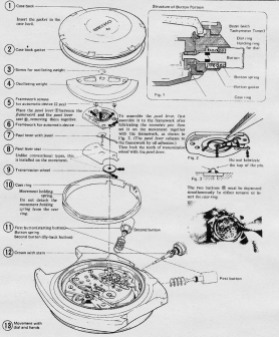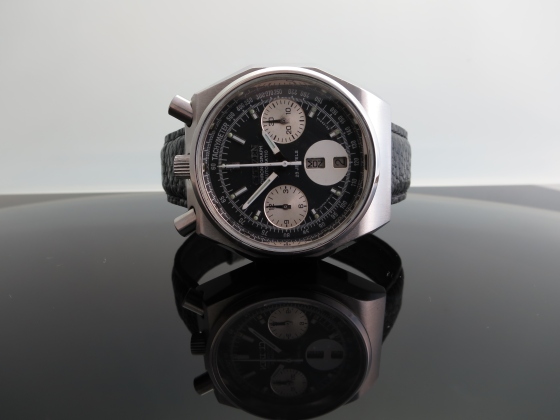
As is well known in the WIS circles, Seiko Suwa was the first Japanese watch company to enter the market for automatic chronographs, and probably the first in the world to bring their products to market. At that time in 1969, it was nothing short of revolutionary, incorporating both a column wheel and vertical clutch system, which was unheard of at that time. Seiko was not the company to invent the vertical clutch system, but was certainly the first to bring this technical piece of achievement back to the forefront of chronograph technology, and many other watch companies have since followed suit and incorporated the vertical clutch system into their chronographs.
Seiko Daini shortly acame up with the 701X family of chronographs in 1970 which was for a time the thinnest vertical clutch chronograph until F. Piguet released the 1185 chronograph in 1987.
Citizen was not resting on it laurels either, but was spurred on to introduce its own range of automatic chronographs in 1973. Given that Citizen was not the first to market, Citizen had the liberty to incorporate and improve on many of the features that was first introduced by the 2 Seiko companies prior.
Let’s take a closer look at the Citizen chronograph and some of its competitors from the same era.
Citizen 8110
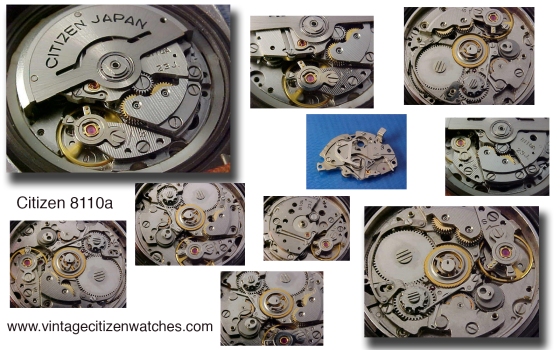
This family was introduced approximately between 1973 and 1980. It beats at 28,800 bph and had a power reserve of 40 hours. It had 23 jewels, and had a 30 minute counter and a 12 hour counter. It had a central sweeping hands, with no constant seconds.It does not hack, but it has a lovely flyback function which allows the user to immediately re-start the timing process without having to first stop and reset the chronograph.The movement can be hand wound and comes with the column wheel vertical clutch system introduced 4 years prior by Seiko. The movement is 27mm wide and 6.90mm thick. This thickness is 1 cm thinner than the 6138 chronograph and only 0.5mm thicker than the 7016.
Seiko 6138
This is the more famous (although less technical advanced) Seiko chronograph movement. It was introduced in 1969 (the 6139 variant) until approximately 1977. It beats at a slower 21,600bph with a power reserve of 45 hours. Similar to the Citizen, it came with the day/date indicator. It had 21 jewels (23 for the rarer JDM variants) and had a 30 minute counter and a 12 hour counter. It also had the central sweeping seconds, and lacks the constant seconds. It does not hack nor hand-wind (unlike the Citizen). It was 27mm in diameter and 7.9mm thick. Its claim to fame are numerous including, being the first automatic chronograph brought to market, being the first watch in space and bringing back the vertical clutch mechanism as mentioned earlier. These days most people would also associate any vintage Seiko chronograph with this family.
Seiko 7016
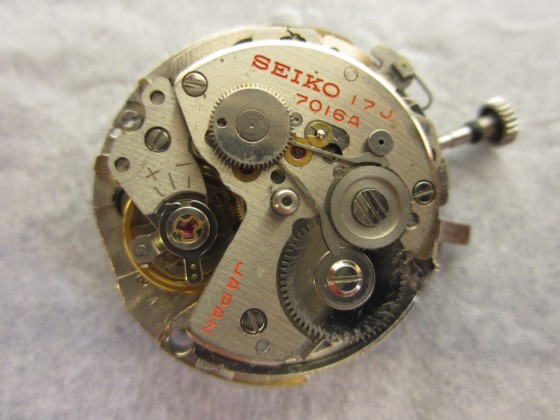
Picture taken from http://watchguy.co.uk
The 7016 is perhaps the more technically advanced of the 2 vintage Seiko chronograph movements because of its additional flyback functionality (similar to the Citizen) and the stacked hour and minute counter. This means that on the same sub-dial, we have both the hour and minute hand counting off the elapsed time, versus the individual hour and minute sub-dials of its 6138 sibling. This makes reading the elapsed time harder, but definitely results in a more compact and cleaner dial design. As mentioned earlier, this was also the thinnest vertical clutch column wheel chronograph for a period of time. This family existed from 1970 – 77. It beats at 21,600bph, and have the central sweeping seconds, with no constant seconds, exactly like its Suwa counterpart. It had 17 jewels and both the day/date complications. Power reserve was approximately 42 hours and it cannot be hand wound nor hacked. Its diameter was approximately 27mm and only an astounding 6.4mm thick.
I would also like to take the opportunity to introduce 2 of the modern Seiko chronograph families here, the Seiko 6S and 8R chronographs.
Seiko 6S
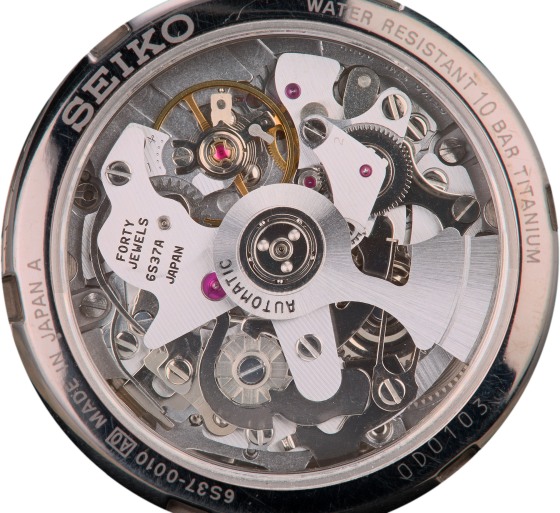
Picture taken from WUS
This family was introduced in 1998 until some time in 2014. Its claim to fame was that it shared the same architecture as the modern GS 9s movement, and was the first modern mechanical chronograph from Seiko. Its claim to infamy in contrast was that Tag Heuer bought the rights to the design and tried to pass it off as a brand new movement developed in-house. This movement still lives on today as the caliber 1887. Surprisingly, Seiko chose not to resurrect the vertical clutch cum column wheel features of both its historical automatic chronographs, but went with a more traditional column wheel horizontal coupling arrangement instead. The 6S family also had a fair number of variants, going from a manual winding only caliber to skeletonised variant to a variant with the power reserve function seen on the fabulous Flightmaster, and finally ending its run with a fairly basic 6S28 (+25 sec / – 15 sec a day) without the power reserve function. Like most modern chronographs, the 6S has a constant seconds feature on top of the central sweeping seconds. It also has a separate 12 hour and 30 minute counter. It has 34 jewels in the base form and came only with the date function. None of the variants have the flyback functionality but it can be hacked and hand wound. The power reserve ranges from 50 hours to 60 hours in some variants. It has a diameter of 28.4mm with a height of 7.20mm.
Seiko 8R
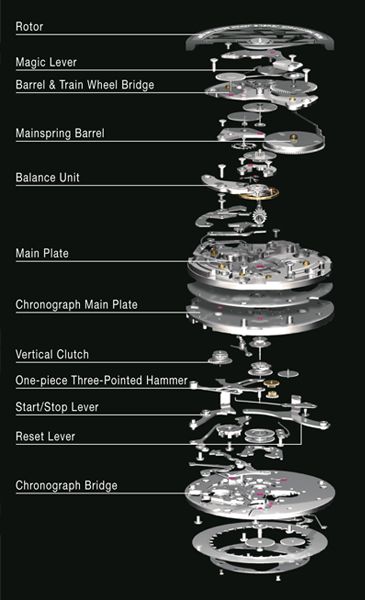
The 8R family is today the flag bearer of the mechanical Seiko chronograph, not by virtue of it being the best that Seiko has to offer (that has to be the 6S chronograph family mentioned prior) but it being the only chronograph family that Seiko has in its stable at the moment The 8R had a 45 hour power reserve and came with the constant seconds, 30 minute counter and 12 hour counter. It had the central sweeping seconds, and beats at 28,800 bph. It hacks and and can be hand wound. It does not have any flyback function but comes with a date function and had 34 jewels. Its diameter was 28mm and a thickness of 7.6mm.
The 8R was introduced in 2008 and was for a time offered together with the 6S family, perhaps as a form of transition.Watches powered by the 6S family were almost always pricier than those powered by the 8R family.
I likened this to the period when the highly regarded 4S family was used in mid-range watches while the lower spec 6R was being developed to fill in the void, before the 4S was retained solely for use in the higher end Brightz and Credor ranges. Unfortunately for the 6S family, this was not the same happy ending that Seiko had planned for it, and the design was instead sold to Tag Heuer as mentioned earlier.
A simple way to differentiate the quality of these 2 modern Seiko chronograph movements was from their pedigree. The 6S was developed from the Grand Seiko 9S family, while the 8R was developed from the basic 700x family, movements that were initially used to power Seiko 5s. Also in contrast to the Seiko 6S which was built from the ground up to be an integrated chronograph, the 8R was a modular setup, albeit with column wheel and vertical clutch features, just like the vintage Seiko chronographs of the past.
Given the modular nature of the 8R family, I cannot help but imagine that the 8R would be miles cheaper to manufacture and service compared to the integrated 6S. Firstly, the base caliber is the easily available 7S/4r/6r movement. Secondly, Seiko can simply and very quickly remove and exchange the chronograph module. Compare this to the 6S, where the base caliber is the hugely more expensive to manufacture (and definitely in much smaller supply) 9S/8L. Being an integrated chronograph would also make servicing it a much less efficient and more cumbersome affair compared to a simple module exchange.
Imagine having a chronograph caliber where you already have the machinery to produce thousands if not hundreds of thousands of the basic caliber yearly, thus lowering the fixed cost of investment even lower and having a faster yet cheaper turnaround time for servicing, thus promising better customer service at a lower cost than before. It was simply a no brainer for Seiko to choose the 8R to be its flagship and sole remaining mechanical chronograph caliber (ignoring the Spring Drive chronograph movements). Sadly for watch enthusiasts like myself, this seems an example where Seiko crossed the line and chose to side with the economics of business over the celebration of craft and quality.
On a separate note, as of today all of Seiko’s current mechanical movements can be divided into 2 main categories, the 9S and its 8L sibling selling for top dollar and the 7S and its related cousins, the 4R, 6R, 8R (all based on the humble 7S) powering the low – mid range watches and its chronographs. Of course one must not forget the 68 series that powers Seiko’s ultra thin watches and tourbillions.
Having introduced briefly the Seiko chronographs of the past and present, let’s head back to the main focus for today, the Citizen 81XX family.
The 81XX powered many different chronograph designs back in the days and an excellent reference for all references can be seen in this excellent post by Sweephand. Also I refer you to this excellent post at VCW specifically about the very same model that I’m writing about today. This model was officially known as the Citizen Challenge Timer and came in a huge array of designs, case materials and dial colors. However as with most vintage chronographs of the 70s, one of the coolest was the Bullhead or Mickey Mouse designs.
These are so called, because the calibers were rotated 90 degrees anticlockwise such that the crown and the 2 chronograph buttons were seated at the 11 o’clock, 12 o’clock and 1 o’clock positions instead of the typical 2 o’clock, 3 o’clock and 4 o’clock positions.
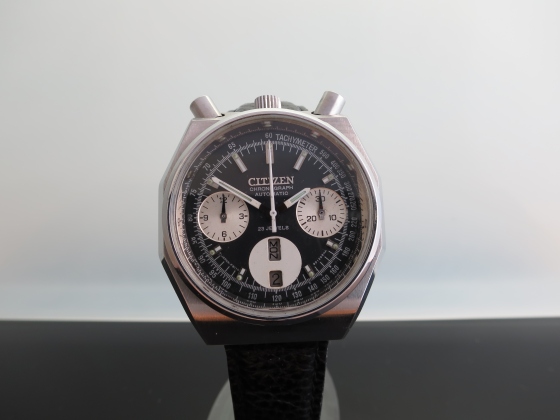
What caught my eye about the Citizen bullheads in contrast to say the vastly popular Seiko bullheads of the same era, was the smaller size and case shape. The stainless steel Citizen bullhead had a very unusual octagonal shape versus the more typical round cases of the Seiko counterparts and the base metal Citizen bullheads.
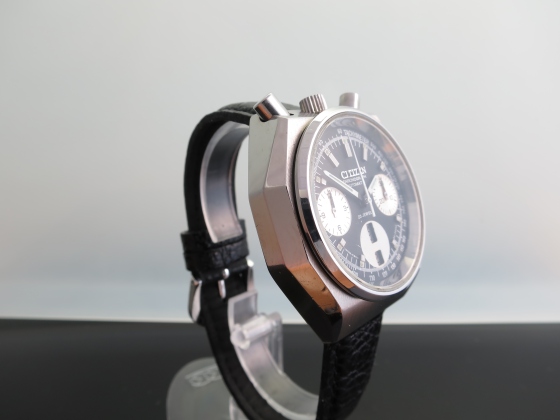
Although it was smaller than the Seiko bullheads, it certainly had its heft as well. I changed it out of its folded links bracelet to a leather strap because the bracelet was too light to counterbalance the head heavy watch (and seriously folded links should just be banned!), while the leather strap allows me to wear the watch head tighter to the wrist and make minute adjustments throughout the day.
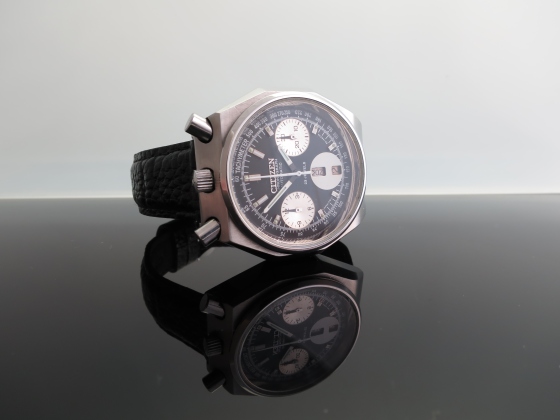
My Citizen Bullhead was a reverse panda, i.e. white sub dials on a black face. There was also a variant that was a proper panda, and these were the only 2 variants of the all stainless steel case.
The Citizen logo is also nicely applied and adds further depth to the dial. Pity that the sub-dials are not on a different level from the main dial, as that would have been added even more depth to the dial.
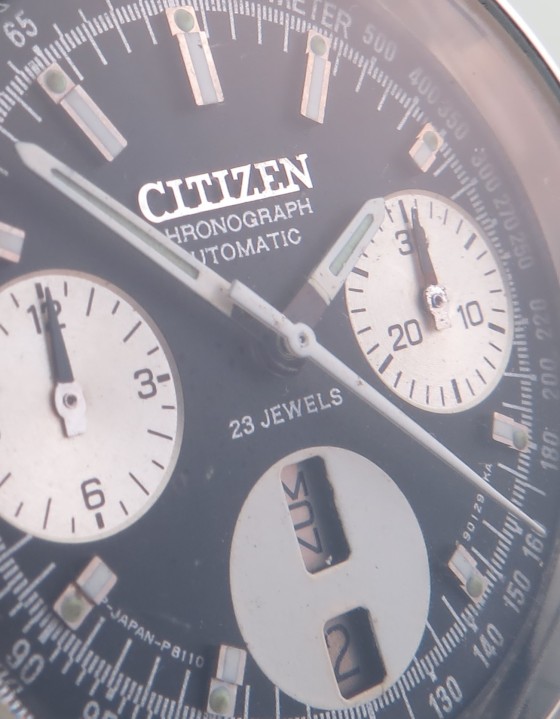
The hour and minute hands are very simple straight parallel hands with pointed tips, with the middle sections hollow for the luminous paint. The second hand on the other hand is painted white all the way and narrows down to a point.
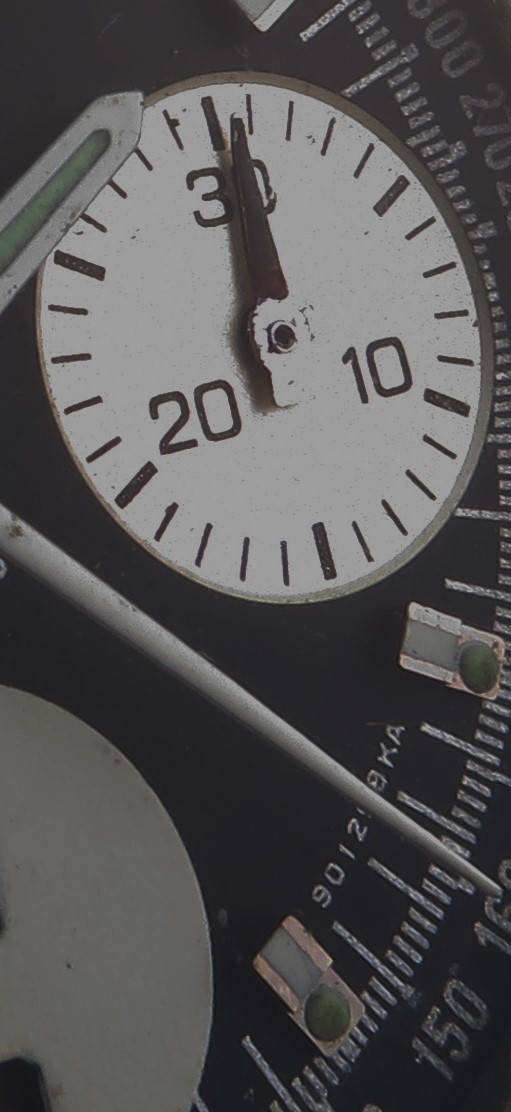
The right sub-dial shows the 30 minute counter. The hand is painted black at the tip, and not at the pinion. One can also see the dial reference number at the 4 o’clock position.
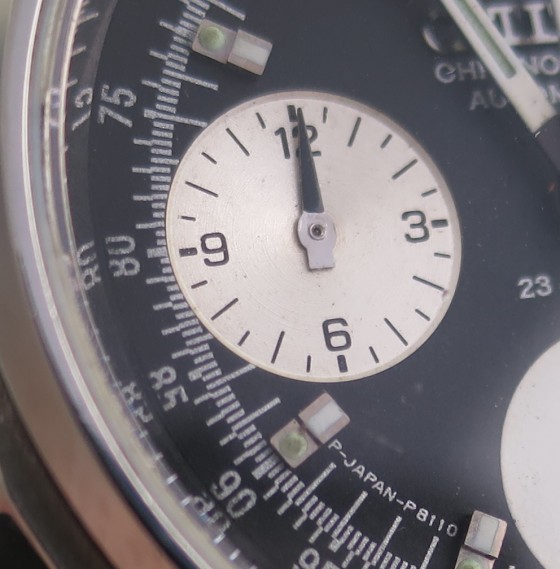
On the left, lies the 12 hour counter. The photo is not sharp enough to show this, but there are concentric circles within the sub-dial. In this picture above, you can also clearly see that the applied hour markers are not flat, but there is a lower step where the lume dot was found. This is also a feature that differentiates an original dial from an aftermarket dial. In the photo above, you can also see the words “P-JAPAN-P8110”, which signifies the usage of a radioactive material. Unfortunately (or perhaps fortunately), the lume on my Citizen is no longer working.
I’ll paraphase from Sweephand’s excellent post:
“Citizen used a radioactive lume on some dials, although there doesn’t appear to be any logical pattern to this, since the same model can either have this type or a non-radioactive lume. This would seem not to be a major concern now since Citizen only used Promethium which is a low energy beta emitter with a half-life of only 2.6 years. Dials with Promethium lume can be identified since they are not simply signed ‘JAPAN’, but are signed ‘P-JAPAN-P’.”
For more tips on how to spot an aftermarket dial, go to this excellent post by VCW.
How to spot a fake dial – Citizen Bullhead
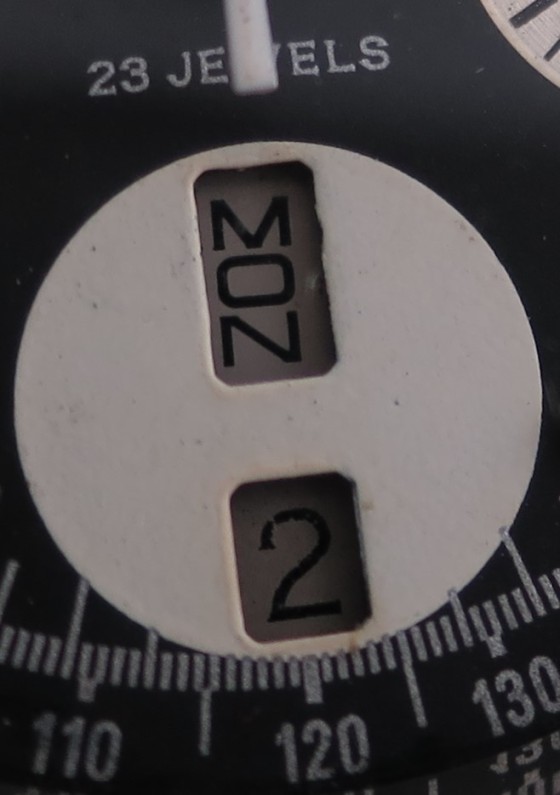
The last sub-dial located at the 6 o’clock position is actually not “real”, rather it simply contains cut-outs to show the day and date complications. This is also very similar to how the Seiko bullheads use their “third” sub dial.
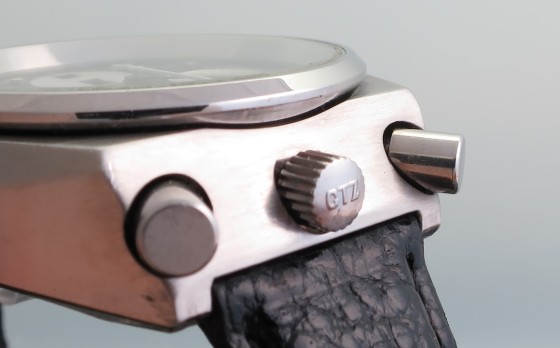
Only the main crown is signed with “CTZ” while the 2 chronograph buttons are completely featureless.
In this picture you can also see that the bullhead is a hooded lug design and this restricts vastly the number of leather straps that I could attach to it due to the tight clearance between the case and the spring bar.
Here you can also see the solid, plain stainless steel bezel. Unlike the base metal Citizen bullheads, the bezel here is of the same color as the watch case. In the base metal bullheads, bezels of a different color from the case can sometimes be found.
It is actually not very obvious on my photo because my example has lost much of its original brushed finishing over the years, but I would like to quote from VCW’s post about the case finishing of this model which was well described and helps me to imagine what it was like fresh from the factory back in the 1970s!
“The case is made of brushed and polished stainless steel and the case back screws into place. The round bezel is polished and the glass crystal is flat. The shape of the watch is octagonal with the lower part dropping towards the bracelet and the upper part, flat, hosting the crown and two push buttons that operate the chronograph function. The winding crown is a little bit longer than the usual so that it can be operated due to the special case design. It is signed “CTZ”. Back to the shape of the case: – all the frontal part is brushed, from top to bottom. The top flat surface is also brushed but from side to side. The sides of the watch are mirror polished reflecting the light in unexpected, beautiful ways. The caseback is also polished. The case alone has on the visible side alone, 21 different surfaces, not counting the bezel, crown and buttons so the visual effect of brushed and polished surfaces, with a lot of angles, gives a powerful feeling.”
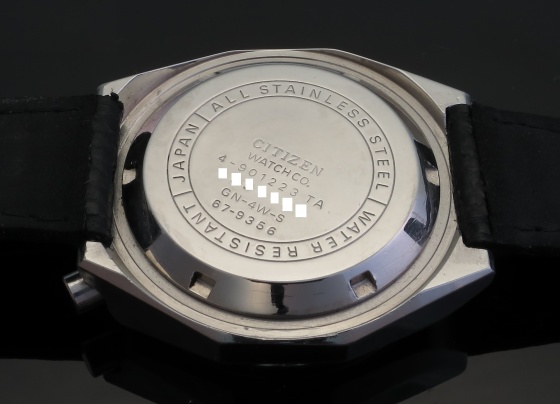
The polished case back contains the usual information of the case number, serial number, etc. Note the words “All Stainless Steel”, as the base metal Citizen bullheads will not state this on their case back.
To conclude, this is a post with a very lengthy lead-in to introduce this awesome, all can-do little Japanese automatic chronograph movement, which is probably better than the Seiko 613x family, but on par with that of the Seiko 701x family in my humble opinion. However given its relatively affordable price, at the moment selling for perhaps half to two thirds that of the equivalent Seiko bullhead, this is definitely a much better value-for-money vintage Japanese chronograph.

